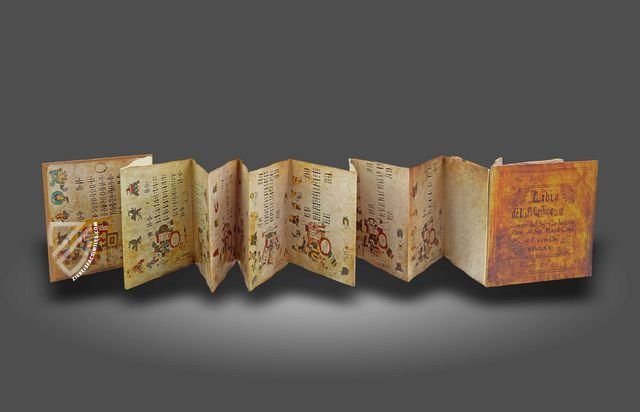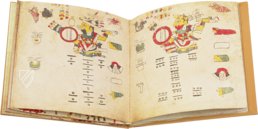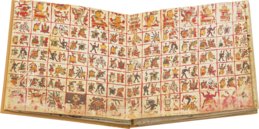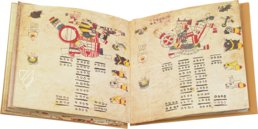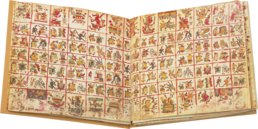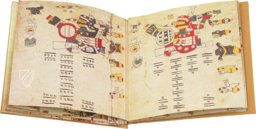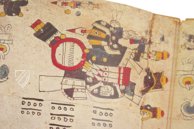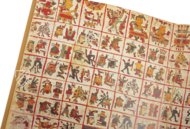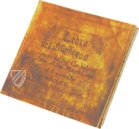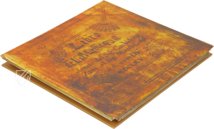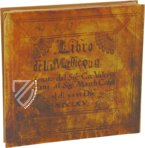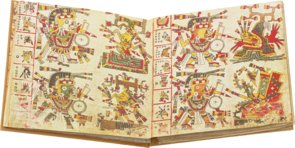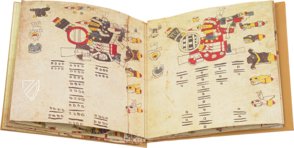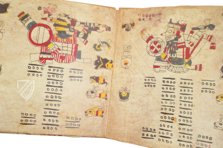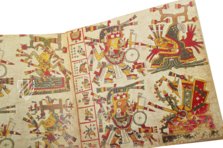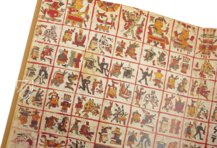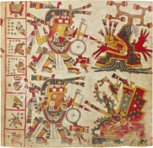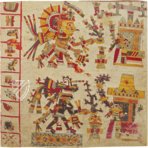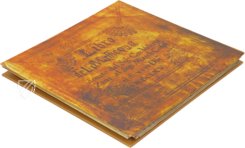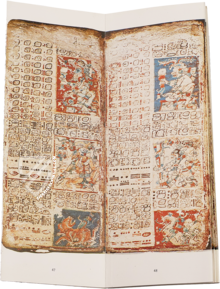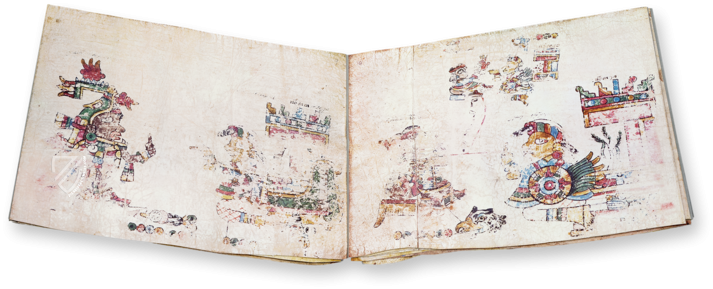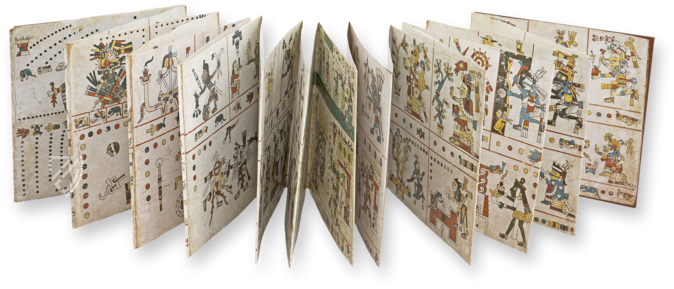Codex Cospi
(1,000€ - 3,000€)
20 is the highest number that man can still count with the help of his body – namely when he uses all his fingers and toes to count. Therefore, the Aztec calendar "Tonalamatl" is based on the number 20 and thus comes to a ritual year of 260 days. Rituals such as the sacrifice of humans with their hearts torn out and that of dogs can be seen in the illustrations of the Codex Cospi. It is often concerned with mantic rituals intended to provide a glimpse into the uncertain future. This is a strange world, but one that can arouse the curiosity of the viewer when he or she browses through the colorful pictures full of symbolism. Stylistically, the illustrations are reminiscent of the elaborate ceramics of the Cholula Tlaxcala and the Nochistlan in the Mixtecan Alta. Together with the Codex Borgia, the Codex Cospi belongs to the Borgia Group of documents from ancient Mexico.
Codex Cospi
The Codex Cospi is a brilliantly illuminated manuscript and belongs to one of the five so-called Codex-Borgia-Group. The manuscript is well preserved, painted on rawhide, and protected by two covers from the 17th century, which probably replaced previous wood covers. The artistic style of the Codex Cospi bears relation not only to the painted ceramics of the Nochistlan in the Mixtecan Alta, but also to the style of the Cholula Tlaxcala. The evaluation of style is challenged by an archaeological problem which through excavations to date has been only partially solved.
The front section of the Codex Cospi consists of three parts in which calendar arrangements in tabular form are connected by sequences of pictures. The original empty pages of the back section were at a later date inscribed by hand. Such rituals have been preserved to the present through different acculturative aspects. The selection of days for the rituals is no longer made according to the old calendar but rather according to the different Christian holy days.
Place in the Borgia Group
Although the exact origins of the Codex Cospi are difficult to determine, it is believed to have originated in the Puebla-Tlaxcala region like the rest of the manuscripts of the Borgia Group. It is most similar to the Codex Borgia itself, particularly with regard to the opening sequences and the depiction of a god with two knives for a head. The contents are religious and divinatory in nature with depictions of deities and priests dressed like them while presenting offerings at temple ceremonies. These rituals, intended for gaining good luck and protection, are often depicted with counted bundles in front of the deities. The miniatures have a comic book-like quality and reflect the political situation of Tlaxcallan, which was completely circled by the Aztec Empire but had been deliberately left independent by the Aztecs as a symbol of their magnanimity.
Codicology
- Alternative Titles
- Codex Bologna
- Size / Format
- 40 pages / 17.80 × 17.85 cm
- Origin
- Mexico
- Date
- 15th – beginning of 16th century
- Epochs
- Style
- Illustrations
- 20 leaves painted on both sides, 24 full-page miniatures total
- Previous Owners
- Pope Clement VII (1478–1534)
Count Valerio Zani
Marchese Ferdinando Cospi (1606–86)
Cospi Museum
Istituto delle Scienze
Codex Cospi
Tlāhuizcalpantecuhtli
The "dart throwing" deity representing the morning star of Venus is Tlāhuizcalpantecuhtli, a principal member of the Aztec pantheon of gods, one of the thirteen Lords of the Day, and one of the four gods who keep the sky up and is associated with the cardinal direction East. He is believed to cause harm to people by shooting darts and his victims vary according to the Aztec calendar. Tlāhuizcalpantecuhtli is even supposed to cause drought by shooting the rain.

Codex Cospi
Tōnatiuh and Itztlacoliuhqui
With his bow-shaped face paint, Tonatiuh holds an incense spoon in one hand from which fragrant smoke, denoted by jewels, rises; in the other hand he holds an incense bag. A flowering tree towers over the temple and a vessel with flowers is in front of it. In its blue interior, a beautiful bird sings a song of gems and flowers.
Itztlacoliuhqui, a form of Tezcatlipoca with its face painting but without the torn foot, is presented as a moon god. Standing on a field of sharp stones, he holds an incense spoon smoking with a burnt offering in one hand and stabs his ear with a bone dagger in the other. In the green interior of the thatched-roof temple, an owl ominously cries "stone and wood" with a noctilucent cloud while a fire vessel burns in front of it.

#1 Codex Cospi
Language: German
(1,000€ - 3,000€)
- Treatises / Secular Books
- Apocalypses / Beatus
- Astronomy / Astrology
- Bestiaries
- Bibles / Gospels
- Chronicles / History / Law
- Geography / Maps
- Saints' Lives
- Islam / Oriental
- Judaism / Hebrew
- Single Leaf Collections
- Leonardo da Vinci
- Literature / Poetry
- Liturgical Manuscripts
- Medicine / Botany / Alchemy
- Music
- Mythology / Prophecies
- Psalters
- Other Religious Books
- Games / Hunting
- Private Devotion Books
- Other Genres
- Afghanistan
- Armenia
- Austria
- Belgium
- Colombia
- Croatia
- Cyprus
- Czech Republic
- Denmark
- Egypt
- Ethiopia
- France
- Germany
- Greece
- Hungary
- India
- Iran
- Iraq
- Israel
- Italy
- Japan
- Lebanon
- Luxembourg
- Mexico
- Morocco
- Netherlands
- Palestine
- Peru
- Poland
- Portugal
- Russia
- Serbia
- Spain
- Sri Lanka
- Sweden
- Switzerland
- Syria
- Turkey
- Ukraine
- United Kingdom
- United States
- Uzbekistan
- Aboca Museum
- Ajuntament de Valencia
- Akademie Verlag
- Akademische Druck- u. Verlagsanstalt (ADEVA)
- Aldo Ausilio Editore - Bottega d’Erasmo
- Alecto Historical Editions
- Alkuin Verlag
- Almqvist & Wiksell
- Amilcare Pizzi
- Andreas & Andreas Verlagsbuchhandlung
- Archa 90
- Archiv Verlag
- Archivi Edizioni
- Arnold Verlag
- ARS
- Ars Magna
- ArtCodex
- AyN Ediciones
- Azimuth Editions
- Badenia Verlag
- Bärenreiter-Verlag
- Belser Verlag
- Belser Verlag / WK Wertkontor
- Benziger Verlag
- Bernardinum Wydawnictwo
- BiblioGemma
- Biblioteca Apostolica Vaticana (Vaticanstadt, Vaticanstadt)
- Bibliotheca Palatina Faksimile Verlag
- Bibliotheca Rara
- Boydell & Brewer
- Bramante Edizioni
- Bredius Genootschap
- Brepols Publishers
- British Library
- C. Weckesser
- Caixa Catalunya
- Canesi
- CAPSA, Ars Scriptoria
- Caratzas Brothers, Publishers
- Carus Verlag
- Casamassima Libri
- Chavane Verlag
- Christian Brandstätter Verlag
- Circulo Cientifico
- Club Bibliófilo Versol
- Club du Livre
- CM Editores
- Collegium Graphicum
- Collezione Apocrifa Da Vinci
- Comissão Nacional para as Comemorações dos Descobrimentos Portugueses
- Coron Verlag
- Corvina
- CTHS
- D. S. Brewer
- Damon
- De Agostini/UTET
- De Nederlandsche Boekhandel
- De Schutter
- Deuschle & Stemmle
- Deutscher Verlag für Kunstwissenschaft
- DIAMM
- Droz
- E. Schreiber Graphische Kunstanstalten
- Ediciones Boreal
- Ediciones Grial
- Ediclube
- Edições Inapa
- Edilan
- Editalia
- Edition Deuschle
- Edition Georg Popp
- Edition Leipzig
- Edition Libri Illustri
- Editiones Reales Sitios S. L.
- Éditions de l'Oiseau Lyre
- Editions Medicina Rara
- Editorial Casariego
- Editorial Mintzoa
- Editrice Antenore
- Editrice Velar
- Edizioni Edison
- Egeria, S.L.
- Eikon Editores
- Electa
- Emery Walker Limited
- Enciclopèdia Catalana
- Eos-Verlag
- Ephesus Publishing
- Ernst Battenberg
- Eugrammia Press
- Extraordinary Editions
- Fackelverlag
- Facsimila Art & Edition
- Facsimile Editions Ltd.
- Facsimilia Art & Edition Ebert KG
- Faksimile Verlag
- Feuermann Verlag
- Folger Shakespeare Library
- Franco Cosimo Panini Editore
- Friedrich Wittig Verlag
- Fundación Hullera Vasco-Leonesa
- G. Braziller
- Gabriele Mazzotta Editore
- Gebr. Mann Verlag
- Gesellschaft für graphische Industrie
- Getty Research Institute
- Giovanni Domenico de Rossi
- Giunti Editore
- Graffiti
- Grafica European Center of Fine Arts
- Guido Pressler
- Guillermo Blazquez
- Gustav Kiepenheuer
- H. N. Abrams
- Harrassowitz
- Helikon
- Hendrickson Publishers
- Henning Oppermann
- Herder Verlag
- Hes & De Graaf Publishers
- Hoepli
- Holbein-Verlag
- Hortus Deliciarum
- Houghton Library
- Hugo Schmidt Verlag
- Idion Verlag
- Il Bulino, edizioni d'arte
- ILte
- Imago
- Insel Verlag
- Instituto Nacional de Antropología e Historia
- Istituto dell'Enciclopedia Italiana - Treccani
- Istituto Ellenico di Studi Bizantini e Postbizantini
- Istituto Geografico De Agostini
- Istituto Poligrafico e Zecca dello Stato
- Italarte Art Establishments
- J. Thorbecke
- Jan Thorbecke Verlag
- Johnson Reprint Corporation
- Josef Stocker
- Josef Stocker-Schmid
- Jugoslavija
- Karl W. Hiersemann
- Kasper Straube
- Kaydeda Ediciones
- Kindler Verlag / Coron Verlag
- Kodansha International Ltd.
- Konrad Kölbl Verlag
- Kurt Wolff Verlag
- La Liberia dello Stato
- La Linea Editrice
- La Meta Editore
- Lambert Schneider
- Landeskreditbank Baden-Württemberg
- Leo S. Olschki
- Les Incunables
- Library of Congress
- Libreria Musicale Italiana
- Lichtdruck
- Lito Immagine Editore
- Lumen Artis
- Lund Humphries
- M. Moleiro Editor
- Maison des Sciences de l'homme et de la société de Poitiers
- Manuscriptum
- Martinus Nijhoff
- Maruzen-Yushodo Co. Ltd.
- MASA
- McGraw-Hill
- Militos
- Millennium Liber
- Müller & Schindler
- Nahar and Steimatzky
- National Library of Wales
- Neri Pozza
- Nova Charta
- Oceanum Verlag
- Odeon
- Orbis Mediaevalis
- Orbis Pictus
- Österreichische Staatsdruckerei
- Oxford University Press
- Pageant Books
- Parzellers Buchverlag
- Patrimonio Ediciones
- Pattloch Verlag
- PIAF
- Pieper Verlag
- Plon-Nourrit et cie
- Prestel Verlag
- Princeton University Press
- Prisma Verlag
- Priuli & Verlucca, editori
- Pro Sport Verlag
- Propyläen Verlag
- Pytheas Books
- Quaternio Verlag Luzern
- Reales Sitios
- Recht-Verlag
- Reichert Verlag
- Reichsdruckerei
- Riehn & Reusch
- Roberto Vattori Editore
- Rosenkilde and Bagger
- Roxburghe Club
- Salerno Editrice
- Sarajevo Svjetlost
- Schöck ArtPrint Kft.
- Scolar Press
- Scrinium
- Scripta Maneant
- Scriptorium
- Siloé, arte y bibliofilia
- SISMEL - Edizioni del Galluzzo
- Sociedad Mexicana de Antropología
- Société des Bibliophiles & Iconophiles de Belgique
- Soncin Publishing
- Sorli Ediciones
- Stainer and Bell
- Studer
- Styria Verlag
- Sumptibus Pragopress
- Szegedi Tudomànyegyetem
- Taberna Libraria
- Tarshish Books
- Taschen
- Tempus Libri
- Testimonio Compañía Editorial
- Thames and Hudson
- The Clear Vue Publishing Partnership Limited
- The Facsimile Codex
- The Folio Society
- The Marquess of Normanby
- The Richard III and Yorkist History Trust
- Tip.Le.Co
- TouchArt
- TREC Publishing House
- TRI Publishing Co.
- Trident Editore
- Typis Regiae Officinae Polygraphicae
- Union Verlag Berlin
- Universidad de Granada
- University of California Press
- University of Chicago Press
- Urs Graf
- Vallecchi
- Van Wijnen
- VCH, Acta Humaniora
- VDI Verlag
- VEB Deutscher Verlag für Musik
- Verlag Anton Pustet / Andreas Verlag
- Verlag Bibliophile Drucke Josef Stocker
- Verlag der Münchner Drucke
- Verlag für Regionalgeschichte
- Verlag Styria
- Vicent Garcia Editores
- W. Turnowsky
- Waanders Printers
- Wiener Mechitharisten-Congregation (Wien, Österreich)
- Wissenschaftliche Buchgesellschaft
- Wydawnictwo Dolnoslaskie
- Xuntanza Editorial
- Zakład Narodowy
- Zollikofer AG

